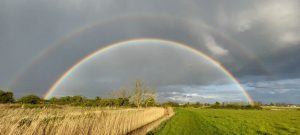A fantastic image of a double rainbow captured by member Kevin Smith whilst on a walk in Deal, Kent on the 16th April 2024.
At 6.35pm Kevin was walking along the marshes to the West of Deal looking East towards the sea, about 700 metres from the beach when he saw the rainbow and used his Samsung A52s mobile phone to take the photo.

”A double rainbow is a wonderful sight where you get two spectacular natural displays for the price of one.
Surprisingly, this phenomenon is actually relatively common, especially at times when the sun is low in the sky such as in the early morning or late afternoon. The second rainbow is fainter and more ‘pastel’ in tone than the primary rainbow because more light escapes from two reflections compared to one.
The secondary rainbow is also dispersed over a wider area of the sky. It is nearly twice as wide as the primary bow.
A key feature of double rainbows is that the colour sequence in the second rainbow is reversed.
The dark band between the two rainbows is known as Alexander’s band, after Alexander of Aphrodisias who first described it in 200AD.
The band forms because between the deviation angles of the primary and secondary rainbows none of the sunlight is scattered by the raindrops towards the observer giving the band of dark sky.
How are double rainbows formed?
Double rainbows are formed when sunlight is reflected twice within a raindrop with the violet light that reaches the observer’s eye coming from the higher raindrops and the red light from lower raindrops.
This means the sequence of colours is inverted compared to the primary rainbow, with the secondary bow appearing about 10 degrees above the primary bow.” Ref:https://www.metoffice.gov.uk/weather/learn-about/weather/optical-effects/rainbows/double-rainbows

0 Comments